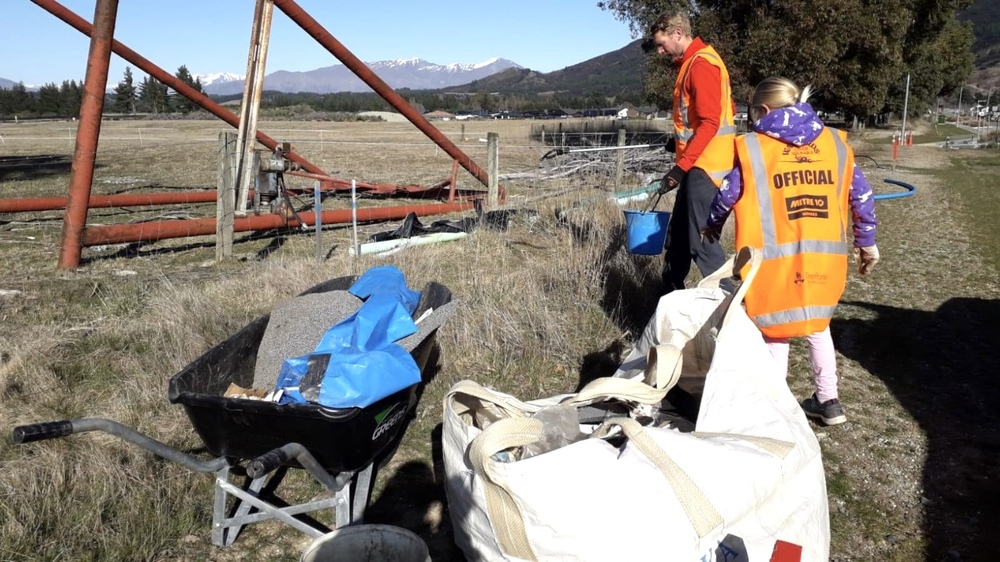Building waste: the ugly side of growth
Maddy Harker
02 October 2022, 4:06 PM
 Construction waste is a “huge” issue says WAO co-founder Monique Kelly. PHOTO: Wānaka App
Construction waste is a “huge” issue says WAO co-founder Monique Kelly. PHOTO: Wānaka AppConstruction and demolition waste makes up around 40-50 percent of waste ending up in landfill nationally, and the Upper Clutha is no exception.
Last week NZ Clean Up Week volunteers said they were shocked to discover so much construction waste in public places and roadsides.
Local advocates for reducing building waste say while some progress is being made it is still a serious problem in the fast-growing town.
Ben Acland is the co-founder of the Wānaka Community Workshop (WCW), a workspace where locals can make things using salvaged products.
“Building and business waste is one of the reasons we began the workshop,” he told the Wānaka App.
“However the issue is so big that we are more of an education or leadership role in this space rather than making a meaningful impact on reducing the vast quantities going to the environment or landfill.”

Hāwea volunteers picked up more than 1,000 pieces of building waste in 300 metres. PHOTO: Supplied
Why so much building waste?
Ben described a straightforward reason for the large volumes of building waste being dumped.
“The main issue is that builders are in a rush, labour is expensive, dumping is cheap,” he said.
“Smaller builders work out of a house, not a shed, [and] they have no storage.”
This perspective is echoed by national advocates like Level: The Authority on Sustainable Building, which says that most of the dumping of secondary waste is unnecessary.
“It has been demonstrated that simply by sorting waste, at least half of it could be diverted from landfills and cleanfills,” the organisation says.
A growing problem?
Chris Champion was one of around 20 volunteers who collected waste from the end of Timsfield Drive in Hāwea earlier this month.
“In 300 metres of litter picking we half filled a high sided trailer with well over a thousand pieces of litter, almost all building waste,” he said.
He expressed concern over how much worse the issue could get with construction booming in the area.
Just a few hundred metres from the clean-up site is the Longview subdivision, which has consent for 465 new lots.
A study by Auckland Council found that an average new house build produces 4.5 tonnes of waste.
That’s roughly the equivalent of putting out the kerbside bin every week for more than 30 years.
WAO co-founder and sustainability advocate Monique Kelly describes construction waste as a “huge” issue.
“When it's not dealt with correctly on site, it litters our land, gets into our soils and waterways and finally our food systems,” she said. “When it does go into a skip, it then gets dumped into landfill in the beautiful Gibbston Valley.”
She said when the waste does make it to landfill, it may be a more contained and controlled way to deal with waste but “it’s just putting the problem out of sight”.
“Both issues need to be addressed.”
Are we making progress?
Monique said WAO has been working with the Better Building Working Group, holding workshops to address the problem and look to better materials and management practices for builders and tradies and peer-to-peer learning.
“[The workshops look] at how to reduce waste in the first place, provides options for reuse, recycling and finally an opportunity to look at problem products and how we can find alternatives or phase them out,” she said.
“Since beginning these workshops in 2019, we've seen an increase in the number of companies reducing their materials footprint as well as a lot of work from suppliers and waste management to look at reduction of waste at the source and more recycling options in our district.”
What’s next?
Ben said there are four practical steps which could help reduce the issue.
Mandatory lids on skips would both stop products from blowing out of them and protect materials that could be reused from being damaged by water, he said.
He’d also like to see Queenstown Lakes District Council (QLDC) create a bond process when issuing building consent, whereby the bond is refunded when builders can demonstrate they have adhered to a waste reduction plan.
Ben would also like to see building suppliers play a role.
“Mitre 10, Placemakers, ITM (etc) should be required to take back over-supplied, or under-utilised orders from customers,” he said, to “store and resell to [the] public for DIY projects. They deliver to sites, so their delivery trucks could return with unused materials.”
Lastly, a public facility where building waste could be sorted before it is dumped would have a big impact, Ben said.
Alongside regulations, Monique says educating the industry about the scale of the problem is essential.
“What we've found is that It's really about behaviour change,” she said.
“Once you know the massive health and environmental impact waste has and then connect that with what we all love about this place, you think twice about the materials you use and how to keep them in circulation for as long as possible.”
“Like anything, the first step is in confronting and owning the problem.”
Get involved
Wao’s next construction waste workshop is taking place on October 26.
The event is designed for sole builders as well as larger construction companies who want to reduce their waste.
Find more information and sign up here.
PHOTO: Supplied




